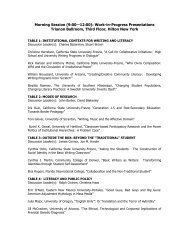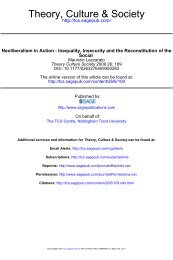Tacit Knowing: Its Bearing on Some Problems of Philosophy
Tacit Knowing: Its Bearing on Some Problems of Philosophy
Tacit Knowing: Its Bearing on Some Problems of Philosophy
Create successful ePaper yourself
Turn your PDF publications into a flip-book with our unique Google optimized e-Paper software.
Michael Polanyi http://faculty.uml.edu/rinnis/45.301%20Ways%20<strong>of</strong>%20Knowi...<br />
would c<strong>on</strong>vert all arts into mathematically prescribed operati<strong>on</strong>s,<br />
and thus destroy them as works <strong>of</strong> art. The analysis <strong>of</strong> art can be<br />
pr<strong>of</strong>oundly revealing, but <strong>on</strong>ly if it remains incomplete. It must<br />
limit itself to the discovery <strong>of</strong> maxims, the applicati<strong>on</strong> <strong>of</strong> which is<br />
itself a work <strong>of</strong> art. However greatly it may pr<strong>of</strong>it from<br />
incorporating a skelet<strong>on</strong> <strong>of</strong> such maxims, the originally tacit act<br />
will still remain tacit, for it will rely <strong>on</strong> a subsidiary awareness <strong>of</strong><br />
its maxims and keep their applicati<strong>on</strong> under tacit c<strong>on</strong>trol.<br />
We can see also, accordingly, that in optical illusi<strong>on</strong>s,<br />
such as that which makes us see a boy taller than a grown man,<br />
‘unc<strong>on</strong>scious reas<strong>on</strong>ing’ can serve <strong>on</strong>ly as the kind <strong>of</strong> rule which<br />
leaves open important alternatives to be decided by a tacit act <strong>of</strong><br />
the subject. Instead <strong>of</strong> the premise “all rooms are rectangular<br />
parallelepipeds,” which leads to the c<strong>on</strong>clusi<strong>on</strong> that a young boy<br />
can be taller than a grown man, we could use the premise “young<br />
boys are smaller than grown men,” and reach the c<strong>on</strong>clusi<strong>on</strong> that<br />
a room can be skew-angled, which would dissolve the illusi<strong>on</strong><br />
and thus show that its formalizati<strong>on</strong> as <strong>of</strong> unc<strong>on</strong>scious reas<strong>on</strong>ing<br />
does not explain why the eye prefers to see the illusi<strong>on</strong>.<br />
The reas<strong>on</strong> for this preference lies in the fact that we<br />
irresistibly see the room as having a normal shape. Our<br />
subsidiary awareness <strong>of</strong> a great many normal rooms presents<br />
itself to us in terms <strong>of</strong> our seeing the room in this way. Most <strong>of</strong><br />
these rooms cannot be identified. We cannot remember more than<br />
a few <strong>of</strong> the thousands <strong>of</strong> regular shaped rooms that we have seen<br />
in the past. Yet it is the joint weight <strong>of</strong> these memories at the<br />
back <strong>of</strong> our mind that is effective, as is shown by the fact that<br />
primitive people who have seen fewer normal rooms are less<br />
susceptible to this kind <strong>of</strong> illusi<strong>on</strong>. [12] Moreover, an undefinable<br />
12. Cf. G. W. Ailport and T. F. Petigrew, J. Abn. Soc. Psych. 55, 104<br />
(1958).<br />
608 Index<br />
range <strong>of</strong> external clues can destroy the illusi<strong>on</strong>. For example, if<br />
we are allowed to tap the wall <strong>of</strong> the room with a stick, at some<br />
point the cumulative effect <strong>of</strong> such clues will cause the skew<br />
room to emerge and the illusi<strong>on</strong> to be destroyed.<br />
This exemplifies the rival attracti<strong>on</strong> <strong>of</strong> two alternative<br />
ways <strong>of</strong> seeing a system <strong>of</strong> clues. The <strong>on</strong>e which prep<strong>on</strong>derates<br />
over the other for any particular c<strong>on</strong>figurati<strong>on</strong>, may be said to be<br />
more readily integrated, or otherwise preferred, by the observer.<br />
Gestalt psychology has attempted to define the qualities <strong>of</strong> a<br />
figure which facilitate its integrati<strong>on</strong>, but my present paper will<br />
not go into this questi<strong>on</strong>. I merely accept it, for example, that<br />
integrati<strong>on</strong> can be destroyed by focusing attenti<strong>on</strong> <strong>on</strong> the<br />
individual particulars and that this is favored by certain ways <strong>of</strong><br />
looking at the integrated whole, e.g., from very near. More about<br />
this later.<br />
The process by which the c<strong>on</strong>cepti<strong>on</strong> <strong>of</strong> a normal room is<br />
formed here, and a particular object identified as an instance <strong>of</strong> it,<br />
bears <strong>on</strong> an ancient problem <strong>of</strong> philosophy, the elucidati<strong>on</strong> <strong>of</strong><br />
which will throw further light <strong>on</strong> the powers <strong>of</strong> tacit integrati<strong>on</strong><br />
and the limit set to a formalizati<strong>on</strong> <strong>of</strong> these powers.<br />
14 <strong>of</strong> 27 1/26/10 9:36 AM





